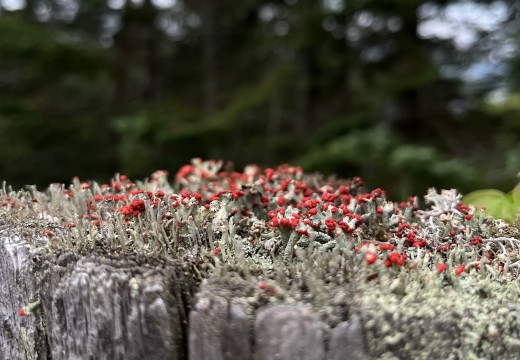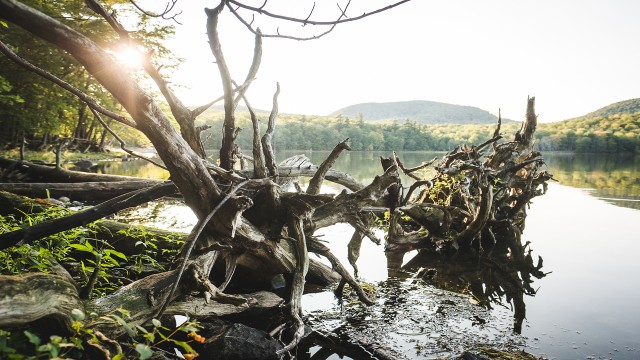When you hike along the trails of the Gault Nature Reserve, you will find an abundance of colourful lichen decorating the trees, rocks and soil surrounding you. While they may look like plants or mosses at first glance, lichens are in fact composite organisms that result from a mutualistic relationship between a fungus and a photosynthetic organism (algae or cyanobacteria). Mutualism occurs when two organisms benefit from an interaction between them. In exchange for a secure, protected environment within the fungus, the alga or bacterium provides nourishment and energy to the fungus in the form of carbohydrates, through photosynthesis.

(Photo: Frédérique Truchon)
There are three types of lichen: foliose (leafy, like lettuce), fruticose (shrubby or hair-like) and crustose (crust-like). Lichen provides food and sustenance to mammals such as deer and forms the nesting material of many birds. Although some lichen will blend in with their surroundings, others, particularly the crustose type, will form brilliant hues of orange, turquoise, yellow or white patches on their substrates. The beauty of lichens has even led to the rise in popularity of Lichen Art, for instance, as people enjoy documenting and sharing their lichen sightings on hikes. The human interest in these elaborate life forms is not new, however, as lichens have been used throughout history as food, medicine, dye, and clothing material.

The Gault Nature Reserve Herbarium's collection of moss and lichens (photo: Alex Tran)
Perhaps the most interesting characteristic of lichen, which also has practical outcomes, is their inherent sensitivity to air pollution. Through photosynthesis, lichens derive their nutrients from the atmosphere, rather than the soil, and as a result, they typically will not survive in highly polluted areas. Each species of lichen has its inherent sensitivity or tolerance to different pollutants like ammonium (NH4+), sulphur dioxide (SO2), or nitrogen dioxide (NO2), with foliose lichen being the most sensitive and crustose lichen being the most robust. The mere presence of lichen, especially the “leafier” varieties, is a good sign of a pure and natural environment!
Environmental scientists use lichen as inexpensive “bioindicators” of air pollution by assessing how frequently they can be found and how much tree surface they cover. Interestingly, lichens bind toxic elemental pollutants and radioactive metals within their fungal threads and can concentrate these pollutants in layers over time. Thus, through sampling lichens and examining their contents, scientists can determine the history of the accumulation of pollutants in different areas and answer many important questions. For example, how would the contents of lichen, if found near a busy highway, compare to lichen found within a pristine and protected area like a national park? Better yet, is the air quality near the parking lot at Gault as clean as the air quality near lake Hertel? These are all intriguing topics that scientists will continue to explore.
Savannah Bissegger-O’Connor
Field Operations Assistant Intern
Gault Nature Reserve of McGill University
Header : Reindeer lichen (Cladonia rangiferina) (photo : Alex Tran)

